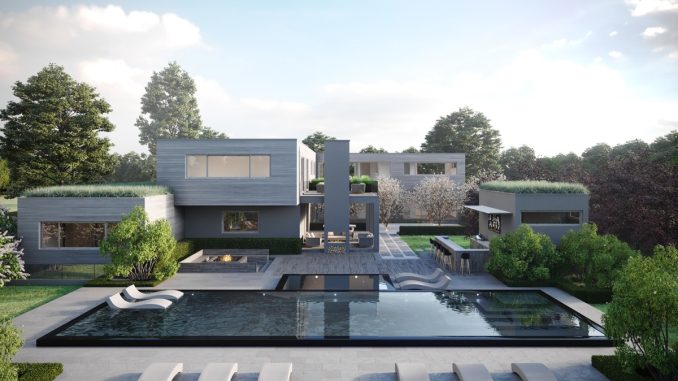
As sustainability and environmental consciousness become increasingly crucial in today’s world, the realm of luxury house architecture has also adapted to incorporate eco-friendly features. The concept of luxury is no longer confined to opulence and extravagance but now includes sustainability and responsible design. This article explores how luxury house design embraces eco-friendly features, highlighting the benefits of sustainable design and the innovative techniques employed to create a harmonious balance between luxury and environmental responsibility.
The Shift Towards Sustainability in Luxury House Architecture
In recent years, there has been a notable shift in the mindset of homeowners and architects towards sustainability. Luxury homeowners are now seeking residences that offer exquisite design and comfort and minimize their ecological footprint. This shift is driven by various factors, including a growing awareness of climate change, a desire to conserve resources, and a need to create healthier living environments. Luxury house architecture has responded by integrating eco-friendly features into the design process.
Energy-Efficient Design for Luxury Homes
One of the critical aspects of eco-friendly luxury house architecture is energy efficiency. Incorporating energy-efficient features helps reduce environmental impact and lowers utility costs for homeowners. Best architects near me employ various strategies, such as optimizing natural lighting by strategically placing windows and skylights, utilizing high-performance insulation materials, and incorporating energy-efficient appliances and lighting systems. Additionally, integrating renewable energy sources, such as solar panels and geothermal heating systems, allows luxury homes to generate clean energy and minimize reliance on traditional power grids.
Sustainable Material Selection
Luxury homes have traditionally relied on rare and exotic materials, often sourced from distant locations, leading to significant carbon emissions from transportation and environmental degradation. However, sustainable material selection is now a priority in luxury house architecture. Architects are increasingly opting for locally sourced, recycled, and renewable materials. For instance, reclaimed wood, salvaged bricks, and recycled glass create stunning features while reducing the demand for new resources. Additionally, advanced techniques, such as bamboo flooring and green roofs, are gaining popularity for their sustainability attributes and unique aesthetic appeal.
Water Conservation Strategies
Water scarcity is a pressing global concern, and luxury homes embrace innovative water conservation strategies. Water-efficient fixtures like low-flow toilets and faucets are standard features in eco-friendly luxury houses. Moreover, architects are incorporating rainwater harvesting systems to collect and reuse rainwater for irrigation and non-potable uses. Sophisticated greywater recycling systems are also being integrated, treating and reusing water from showers, sinks, and washing machines. These conservation measures reduce water consumption and contribute to the overall sustainability of luxury homes.
Intelligent Home Automation Systems
Advancements in technology have revolutionized the way luxury homes operate, leading to the development of intelligent home automation systems. These systems provide convenience and comfort and contribute to energy efficiency and sustainability. Smart thermostats, lighting controls, and automated shading systems optimize energy usage by adapting to occupants’ preferences and environmental conditions. Integration with renewable energy systems allows homeowners to monitor and manage energy consumption, leading to more efficient and sustainable living.
Biophilic Design and Indoor Air Quality
Biophilic design, which emphasizes the connection between humans and nature, is gaining traction in luxury house architecture. Incorporating natural elements, such as living green walls, indoor gardens, and ample natural ventilation, enhances the aesthetic appeal and improves indoor air quality. Selecting non-toxic and low-emission materials and implementing advanced air filtration systems ensure a healthy living environment for luxury homeowners. Biophilic design principles promote well-being and reduce stress, creating a harmonious and sustainable living experience.
Integration of Smart Grid Technology
Luxury homes are increasingly integrating with intelligent grid technology to enhance sustainability further. Smart grids enable efficient management of energy consumption by optimizing renewable energy sources and allowing homeowners to monitor and control their energy usage in real-time. By integrating luxury homes with intelligent grids, homeowners can contribute to the stability of the overall energy system and play an active role in reducing their carbon footprint.
Community Engagement and Social Responsibility
Luxury house architecture is limited to individual residences and extends to sustainable community planning. Developers and architects are incorporating green spaces, pedestrian-friendly designs, and sustainable infrastructure in luxury housing communities. Additionally, luxury homeowners are becoming more engaged in social responsibility initiatives, such as community gardens, renewable energy cooperatives, and eco-conscious events. These efforts foster a sense of community and promote a collective commitment to sustainability.
Conclusion
The future of modern residential architecture lies in the seamless integration of luxury, comfort, and eco-friendly features. As homeowners and architects embrace sustainability, luxury homes are evolving to reflect this new paradigm. Energy efficiency, sustainable material selection, water conservation, intelligent home automation, biophilic design, and integration with smart grids are transforming luxury houses into sustainable havens. Luxury house architecture sets new standards for responsible living and environmental stewardship by designing for the future with eco-friendly features.
Leave a Reply